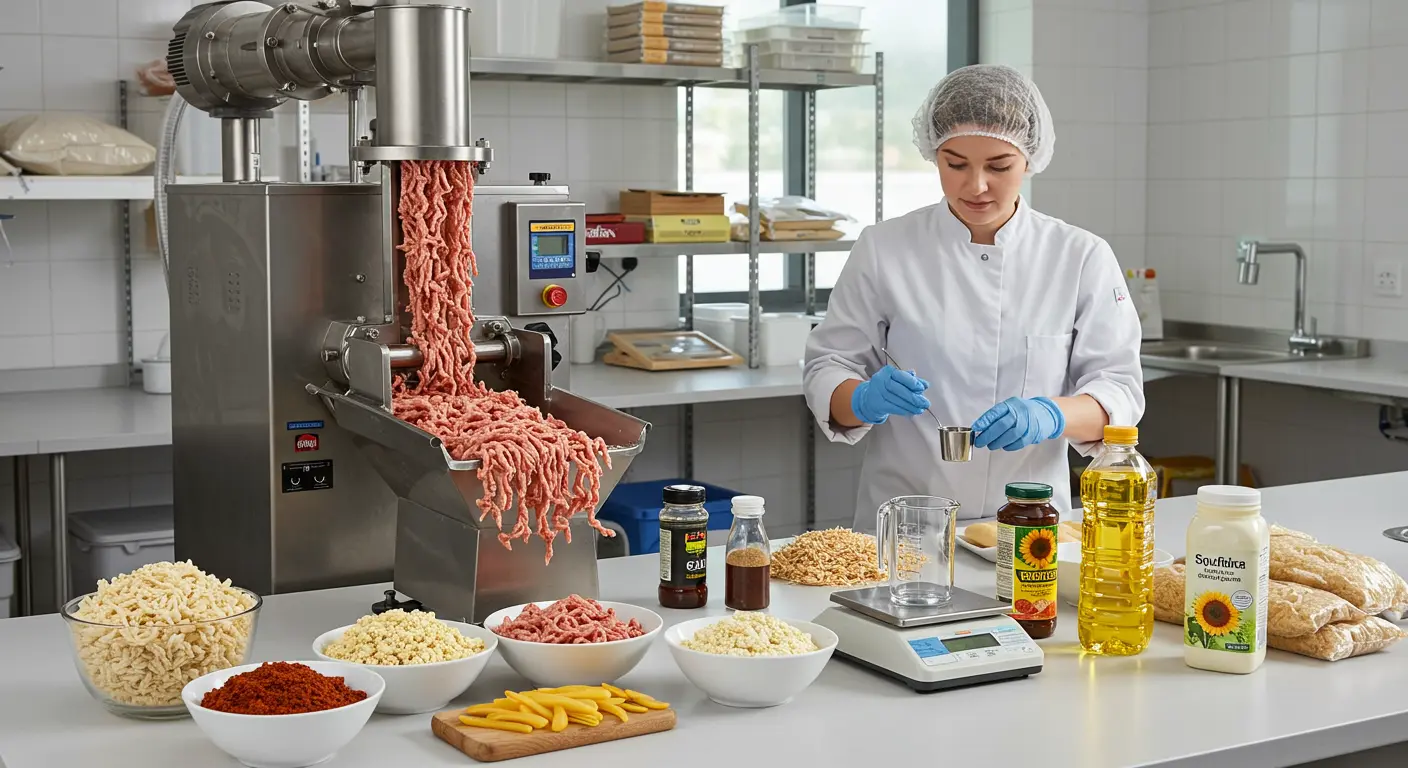Understanding Plant-Based Meat – What Is It?
Plant-based meat represents a culinary innovation designed to replicate the taste, texture, and visual appeal of traditional animal meat using exclusively plant-derived ingredients. Free from any animal tissue, these alternatives cater to vegetarians, vegans, and flexitarians seeking to reduce their meat consumption.
Fundamentally, plant-based meat emerges from an intricate manufacturing process that transforms plant proteins into products mimicking conventional meat. Manufacturers extract proteins from raw materials—soybeans, peas, wheat—then transform them through precise heating and extrusion techniques. This process realigns plant proteins into fibrous architectures that mirror the muscle tissue found in animal meat. After establishing the base structure, producers incorporate plant-based fats, natural colorings, flavors, and aromas to enhance the meat-like experience.
These products don’t merely aim to replicate conventional meat’s taste—they strive to mirror its cooking behavior across diverse formats. From ground applications like burgers to whole-muscle cuts resembling steaks, they deliver a reassuringly familiar culinary experience.
A crucial distinction exists between plant-based meat from lab-grown meat (also called cultured or cell-based meat). Plant-based meat relies entirely on botanical ingredients, whereas lab-grown meat cultivates actual animal cells in controlled laboratory environments—eliminating the need for raising and slaughtering livestock. Both approaches aim to address environmental and ethical concerns associated with traditional animal agriculture, but through fundamentally different methods.
The foundational elements in most plant-based meats include:
-
Protein sources: Soy, pea, or wheat gluten.
-
Plant oils: Sunflower, coconut, or canola oil.
-
Binding agents: Methyl cellulose, flour, or starches.
Key Ingredients in Plant-Based Meat Production
Plant Proteins – The Backbone of Vegan Meat
Plant proteins form the architectural foundation of plant-based meat, delivering the essential structure, texture, and nutritional backbone that transforms them into credible substitutes for animal products.
Soy protein continues to dominate the landscape due to its complete amino acid profile and exceptional functionality. Its high protein content (typically 90% in isolate form) and excellent water absorption capabilities make it ideal for creating fibrous textures. Its mild flavor works well with meat-like seasonings, while its exceptional gel-forming properties deliver the satisfying chewiness consumers crave.
Pea protein has surged as a compelling alternative, particularly appealing to consumers with soy allergies or those seeking non-GMO options. This legume-derived protein boasts impressive gelling properties and robust fat absorption capacity. However, it presents formulation challenges—its distinctive flavor notes require careful masking. Its growing popularity comes from sustainability advantages: reduced water and fertilizer requirements compared to soy, plus the added benefit of nitrogen fixation in soil.
Wheat gluten—better known as Satan—delivers unmatched elasticity and chewiness through its high gluten in and gliding content, making it particularly suitable for whole-muscle meat analogs like chicken alternatives. When properly hydrated and stretched, these proteins create remarkably aligned fibrous structures that closely mirror animal muscle tissue. However, its application is limited in gluten-free formulations, driving manufacturers to explore alternative protein sources.
These proteins’ functional properties depend on their amino acid composition and molecular architecture. Manufacturing employs sophisticated techniques—pH adjustment, heat treatment, mechanical shearing—to reshape protein structures and improve their meat-like qualities. The precise selection and combination of different plant proteins allow manufacturers to fine-tune the textural attributes of the final product, balancing firmness, elasticity, and moisture retention to create increasingly convincing meat alternatives.
The Role of Fats and Carbohydrates
Though proteins establish the structural foundation, fats and carbohydrates play equally important roles in creating products that convincingly replicate animal meat’s sensory experience. These components create the mouthfeel, juiciness, and satisfaction that consumers demand from meat alternatives.
Plant-derived fats are essential for replicating the rich, succulent qualities that define animal products. Manufacturers typically incorporate oils such as sunflower, coconut, or canola to replicate the marbling and juiciness found in conventional meat. Unlike animal fats that naturally solidify at room temperature, plant oils demand specialized processing techniques to achieve comparable stability and texture. Coconut oil works especially well for this purpose. Its elevated melting point creates fat pockets that dramatically melt during cooking, creating that characteristic sizzle and burst of flavor compounds that meat enthusiasts crave. Some advanced formulations use structured lipid systems that solidify and melt at specific temperatures, creating a more authentic cooking experience.
Carbohydrates fulfill multiple technical roles within plant-based meat formulations. Starches from sources like potato, tapioca, or corn act as binding agents that improve product cohesion and moisture retention. These ingredients address a common problem with early meat alternatives: the tendency to become dry or crumbly during cooking. Dietary fibers, including methyl cellulose, Konrad, or various plant-derived gums, contribute crucial textural elements by forming gel networks that mimic the fibrous structure of muscle tissue. These fibers also enhance nutritional profiles by amplifying fiber content—a distinct advantage plant-based meats hold over their animal counterparts.
The delicate equilibrium between fats and carbohydrates significantly affects both sensory qualities and nutritional value. Excessive fat creates calorically dense, potentially unhealthy products. Insufficient fat? Dry, unpalatable alternatives. Similarly, carbohydrate selection affects cooking behavior, with some starches providing better browning capabilities through Maillard reactions. Manufacturers must find the right balance where taste, texture, and nutrition converge to satisfy increasingly discerning consumers seeking healthier options without culinary compromise.
The Production Process of Plant-Based Meat
Extrication Techniques – Creating Meat-Like Structures
Replicating the intricate fibrous architecture of animal muscle tissue represents one of the biggest challenges in plant-based meat production. Manufacturers employ several sophisticated extrication techniques to transform plant proteins into convincing meat analogs with the characteristic bite, chew, and mouthfeel consumers expect.
Extrusion technology serves as the industry standard for generating fibrous textures at commercial scale. During this process, moistened plant proteins are subjected to precise combinations of heat, pressure, and mechanical shear as they move through specialized equipment. The high-moisture twin-screw extrusion method works particularly well—it enables protein molecules to realign into anisotropic structures that convincingly mimic muscle fibers. The extruded material emerges with a layered, fibrous quality that, when properly formulated, can closely resemble chicken breast tissue or beef muscle.
Beyond traditional extrusion, new extrication methods have emerged. Shear cell technology applies controlled deformation forces to plant protein mixtures, creating aligned fibrous structures without the high energy requirements of extrusion. Electro spinning—though still largely confined to research laboratories—harnesses electrical charges to craft ultra-fine protein fibers that layer into remarkably complex structures. For products requiring specific texture profiles, manufacturers sometimes employ hybrid approaches combining multiple extrication methods—for instance, incorporating extruded protein chunks into a softer matrix to simulate the varied texture of ground meat products.
Protein source selection significantly affects extrication outcomes. Soy protein isolates and concentrates offer excellent functionality for creating fibrous structures due to their balanced amino acid profile and good relation properties. Pea protein, despite its surging popularity in allergen-free formulations, typically demands additional processing or strategic blending to achieve optimal extrication. Wheat gluten provides exceptional elasticity and chewiness, making it ideal for certain applications despite allergen concerns. Emerging proteins from mung beans, lava beans, and algae are expanding extrication options. Each brings distinctive functional properties that promise to elevate structural development in next-generation plant-based meats.
Flavor and Appearance – Mimicking Real Meat
Once texture hurdles are conquered, manufacturers face another major challenge: faithfully replicating animal meat’s distinctive flavor profile and visual characteristics. This sensory dimension is essential for consumer acceptance and requires a sophisticated blend of ingredients and technologies.
Flavor development typically begins with a foundation of: natural flavorings, meticulously selected spices, and yeast extracts that contribute those complex umami and savory notes synonymous with meat. These compounds work synergistically to create depth of flavor, while strategic incorporation of plant oils provides the richness and mouthfeel associated with animal fats. Fat content serves dual purposes—it carries flavor compounds while delivering that anticipated juiciness when consumers bite into a burger or sausage.
A major breakthrough in flavor technology is The introduction of heme—an iron-containing molecule naturally present in all living organisms. In plant-based meat applications, heme acts as a transformative ingredient that catalyzes the authentic meaty flavor development during cooking. When heated, this remarkable compound triggers the identical Maillard reaction occurring in animal meat, generating that distinctive aroma and taste that convinces our brains we’re consuming beef. The presence of heme significantly enhances the boldness and authenticity of the flavor profile, addressing one of the most persistent challenges in plant-based meat development.
Visual appeal receives equal attention throughout the manufacturing process. To mimic the appearance of raw meat that transforms during cooking, producers employ various techniques including specialized extrusion processes that create visual marbling effects. Some manufacturers have pioneered methods for incorporating plant-based soft fats through extruders, creating visible fat pockets that mirror those found in ground beef. For products designed to replicate the experience of a medium-rare burger, heme also contributes a remarkable visual element—it creates the ”bleeding” effect that consumers associate with properly cooked beef, changing color from red to brown during the cooking process. These visual cues, combined with carefully calibrated textures and flavors, create a multisensory experience that increasingly rivals conventional meat products.
Health and Sustainability Benefits of Plant-Based Meat
Plant-based meat alternatives’ surging popularity transcends mere culinary innovation. These products deliver substantial health and environmental advantages that increasingly fuel consumer adoption.
Nutritionally speaking, well-formulated plant-based meats typically contain less saturated fat and fewer calories than their animal counterparts. They also supply dietary fiber—completely absent in conventional meat—while matching protein delivery. Research indicates that substituting animal protein with plant-based alternatives is linked to significant health benefits, including a lower risk of:
-
Cardiovascular disease
-
Type 2 diabetes
-
Overall mortality (Zheng et al., 2019; Neuenschwander et al., 2023)
Plant-based meat production’s environmental impact presents another compelling advantage. Conventional animal agriculture demands enormous resources—substantial land, water, and feed inputs—while generating considerable greenhouse gas emissions. In contrast, plant-based alternatives generally require less agricultural land, consume fewer water resources, and produce a smaller carbon footprint. Consider this striking comparison: producing a plant-based burger typically generates 90% fewer greenhouse gas emissions and requires 99% less water than creating an equivalent beef burger.
Nutritional quality, however, varies dramatically across the plant-based meat landscape. Some products feature minimal processing and wholesome ingredients. Others? They may pack higher sodium levels, refined oils, or various additives to achieve desired sensory properties. Health-conscious consumers should review nutrition labels carefully, paying particular attention to sodium content, ingredient quality, and processing methods. Nutritionists generally recommend incorporating plant-based meats as part of a balanced diet that includes plenty of whole, minimally processed foods rather than relying on them as daily staples.
As manufacturing technologies evolve, plant-based meats’ nutritional profiles continue improving. Many companies are actively working to reduce sodium levels, incorporate more nutrient-dense ingredients, and minimize processing while maintaining the taste and texture characteristics that consumers expect. This relentless evolution suggests that plant-based meats’ health and sustainability benefits will likely amplify in coming years.
Future Innovations in Plant-Based Meat Production
The plant-based meat industry stands at the edge of a technological revolution poised to transform how these products are conceived, manufactured, and experienced by consumers. As research accelerates and investment continues to flow into this sector, several key innovations are emerging that will likely define the next generation of plant-based alternatives.
Advanced manufacturing methods like 3D printing lead this evolution, delivering unprecedented precision in replicating intricate muscle structures. This technology enables the creation of elaborate internal architectures that better mimic whole-muscle cut textures—an approach pioneered by companies like Redefine Meat and Nova meat to achieve textures beyond conventional extrusion’s reach.
Fermentation technology represents another important frontier. While traditional fermentation has long served food production, newer approaches like precision fermentation enable the creation of specific proteins and flavor compounds identical to those in animal products. Companies are using microorganisms to produce heme proteins, dairy proteins, and other compounds that contribute to the authentic taste and functionality of animal products without requiring animals themselves. This approach combines the sustainability benefits of plant-based production with the sensory experience of animal products.
The ingredient landscape is expanding rapidly. Beyond the current reliance on soy, wheat, and pea proteins, researchers are exploring novel protein sources including algae, fungi, duckweed, and various underutilized legumes and grains. These alternative proteins often provide enhanced nutritional profiles, distinctive functional properties, and potentially reduced environmental footprints. Mucoproteins derived from fungi, for example, naturally create fibrous structures that closely resemble muscle tissue without extensive processing.
Consumer demand simultaneously propels innovation toward cleaner labels and superior nutrition. The next generation of plant-based meats will likely feature shorter, simpler ingredient lists with reduced sodium, fewer additives, and improved nutritional profiles that incorporate beneficial nutrients like fiber and vitamins. This optimization seeks to position them not merely as alternatives, but as nutritionally superior choices.
Artificial intelligence and machine learning integration significantly speeds up development. These sophisticated tools identify optimal ingredient combinations and processing parameters by analyzing massive datasets, predicting how ingredients will generate specific flavors, textures, and cooking behaviors—significantly reducing product development timelines.
As these innovations converge, the plant-based meat sector is ready for expansion into novel formats and markets—from seafood alternatives to specialized cultural products—meeting growing global demand. This expansion, coupled with continuous improvements in taste, texture, and affordability, suggests plant-based meats will become mainstream options, potentially changing global protein consumption patterns.




